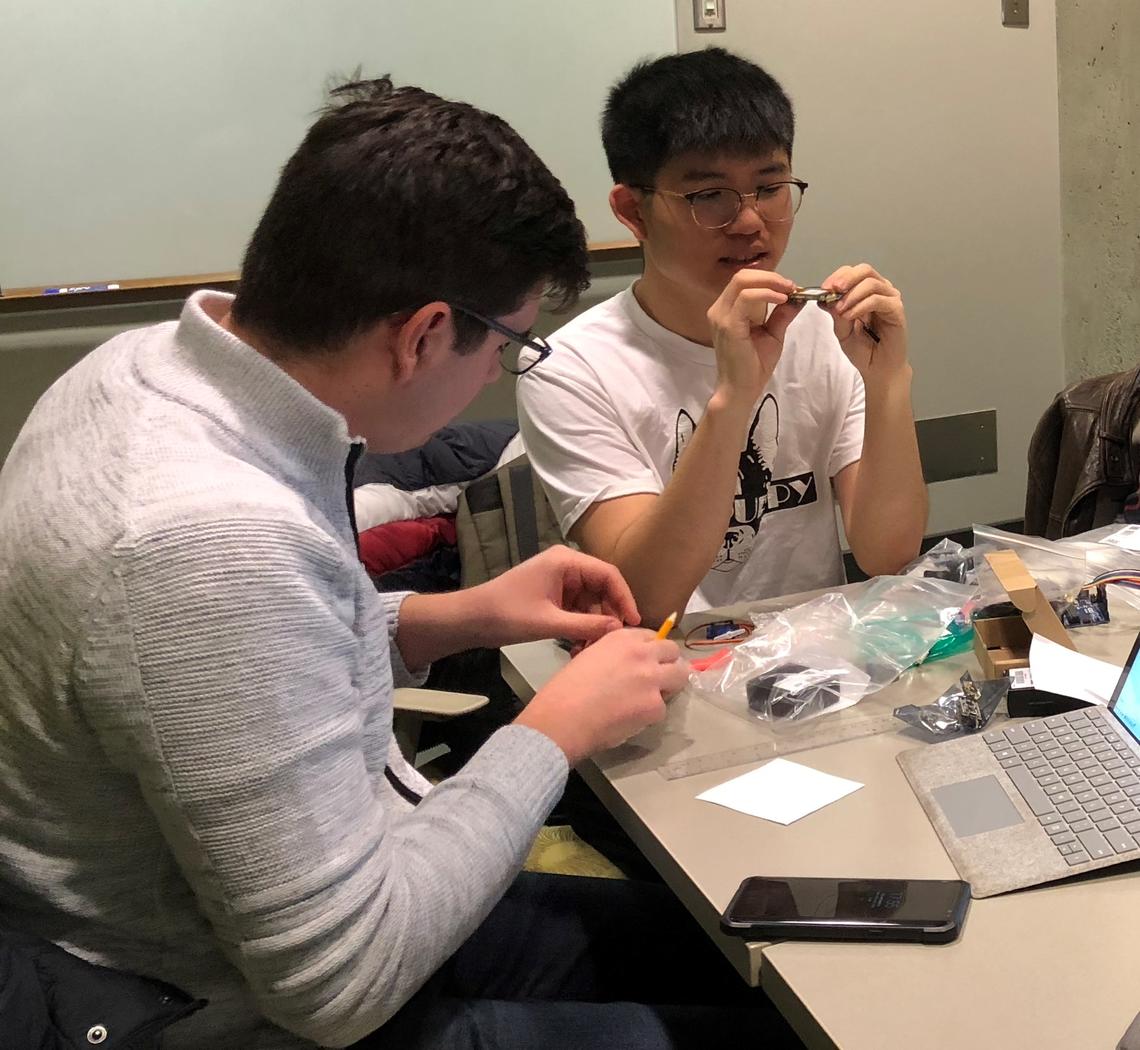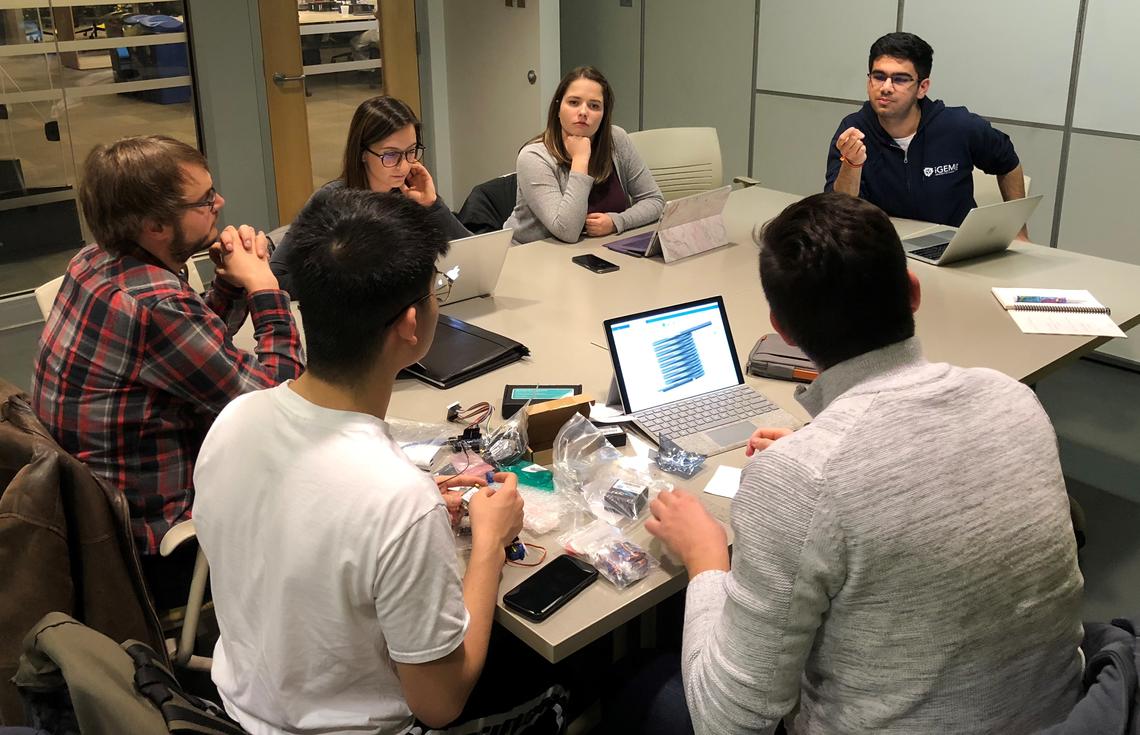Nov. 21, 2018
As deadline looms, students build a prototype device to help save lives from fentanyl overdose

University of Calgary students Sabin Nastase and Douglas Liao.
Jennifer Allford, for University Relations
The team is already sitting around the table, laptops open, when Douglas Liao arrives and starts pulling packets of electrical components out of his backpack. “I’ve been dreaming about this one,” says Sabin Nastase, as he grabs a small circuit and pulls the plastic away. Across the room, Nilesh Sharma puts his phone down on the table where Dr. Fernando Mejia is on speaker, a tinny voice apologizing for missing tonight’s meeting. He’s on call and can’t get away.
The University of Calgary students are squirreled away in a small meeting room discussing a very big idea: How to build a device that will save people from dying of fentanyl overdoses. They’re one of 19 teams taking part in Innovation 4 Health (I4H), a competition connecting people who have innovative health-care ideas with multidisciplinary student teams and mentors from academia and industry. This year, teams are working on diagnostic and imaging solutions.
- Above: Preparing for the 2018 Health Hack Competition at the University of Calgary, members of a team tackling Fernando Mejia's idea get to work at a weekly meeting. From left: Alexander Cobban, Douglas Liao, Dion Kelly, Kristina Komarek, Sabin Nastase and Nilesh Sharma.
After watching Canada’s fentanyl crisis get worse and worse, Mejia, MD, a fourth-year resident in public health and preventive medicine at the Cumming School of Medicine (CSM), had a notion about how to help. “I thought about developing a device that could track signs of overdose and deliver the necessary amount of naloxone. At the same time, the device would be able to alert emergency services. It’s feasible but I need expertise.”
Choosing the team
Mejia was one of several “champions” who brought their ideas to a pitch session Oct. 12, where an atrium full of students waited to sign up for a project. Fourteen students, all with valuable expertise, wanted to build Mejia’s device but he could only have seven on the team. He had to choose.
“Fernando just told us to give a 30-second spiel about what you can contribute to the project, right on the spot,” says Nilesh Sharma, a master's student in the Department of Comparative Biology and Experimental Medicine at the Faculty of Veterinary Medicine. “We were pretty caught off guard. We were pretty nervous.”
Mejia was impressed with all 14 students’ elevator pitches. He thought of another little test. “I asked who would be willing to put money in this project right now. They all said yes! Then I had to decide. It was tough.” In the end, he chose a team with a broad range of knowledge — graduate students studying neuroscience, veterinary medicine, biochemistry and molecular biology and undergraduate students in computer science and engineering.
The team had six weeks to design the device, order parts and get ready to build a prototype in 72 hours at the I4H Health Hack Weekend, taking place Nov. 23-25. Sharma is in charge of the sensors to detect the levels of fentanyl. Nastase is figuring out how the device will administer the naloxone. Liao, a computer science undergraduate, is getting the electronic components. Kristina Komarek is bringing her expertise in opioids. “I’ve been so impressed and so excited about all the different things that are happening,” says Mejia. “I see a lot of teamwork.”
University of Calgary students Sabin Nastase and Douglas Liao (below) examine some of the electrical components they will use to build a prototype device.

Fernando Meija's team for the 2018 Health Hack Competition.
Jennifer Allford, for University Relations
A fly in the ointment
Two weeks in, the team hit a snag. Dion Kelly, a master's student in the CSM’s neuroscience graduate program, was doing the patent search and made an unsettling discovery.
“I had to break it to these guys. I came across a patent that was literally exactly what we had all envisioned this being. That threw a wrench into things,” says Kelly. “We had to figure out what we were going to do to make it sufficiently different so we weren’t infringing on this existing patent.” The team worked with an I4H adviser from Innovate Calgary and with four weeks left, they got the design back on track, changing it from a device worn on the wrist, to one applied to the chest.
“Every meeting is a conversation, sometimes they get heated,” says Nastase, who is also in the CSM’s neuroscience graduate program. “The truth is we all have the project at heart. We are all invested in this. We all care about it and we think it’s a great idea.”
Judges will pick winners Nov. 26
After the teams present their prototypes — everything from a wearable device to monitor concussion patients, to an app to help nurses in intensive care — a panel of eight judges from across Alberta’s medical innovation community will choose five winning teams. They are competing for a total prize package of $20,000 in financial support and $20,000 in-kind services to help them develop their idea.
“I think we have what it takes to win,” says Mejia. “I am a competitor, I like winning but the most important thing is this project can save lives. When you win a contest like this you will have the support and opportunity to address a nationwide problem.”
Six biomedical engineering graduate students started I4H last year because of their own frustrations taking health-care solutions for people and animals from the bench to the bedside. “You need engineers, doctors, veterinarians, business people and other skills,” says Abdullah Al-Ani, one of the founders who is in the Leaders in Medicine program, and the Biomedical Engineering Graduate Program. The competition has attracted students and innovators from a variety of different disciplines. “They’re people who wouldn’t have met if it wasn’t for an event like this,” he says. “We believe you need all hands on deck.”
Come out and cheer on the teams on Demo Day
- Date and time: Nov. 26, 2018, 5:30-10 p.m.
- Location: Energy, Environment, Experiential Learning (EEEL) building
- Register to attend the event
I4H is supported by The Hunter Hub for Entrepreneurial Thinking, Cumming School of Medicine, Graduate Students' Association, Biomedical Engineering Graduate Program, Biomedical Engineering Calgary, Faculty of Veterinary Medicine, McCaig Insitute for Bone and Joint Health, and several community and award sponsors.
The University of Calgary’s multidisciplinary Engineering Solutions for Health: Biomedical Engineering research strategy drives solutions to our most pressing health challenges in disease and injury prevention, diagnosis and treatments. Our biomedical engineering researchers make a significant impact in our communities by extending lives, improving quality of life, promoting independence, and continuously improving the health system.
